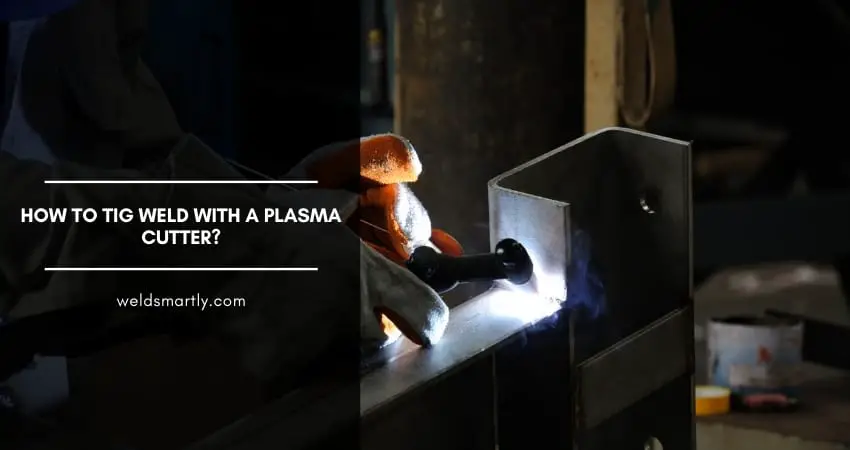When welding different metals, you can’t find something better than TIG welding. Whereas a plasma cutter rules in cutting various metals using agility and speed. But the question is- can you TIG weld with a plasma cutter?
You can TIG weld with a plasma cutter if you’re using a multi-purpose machine. These machines combine multiple tools that eliminate the necessity of using separate tools for different tasks.
If you wish to know how the process works, I recommend reading the whole article. I’ve tried to put together all the information you need.
TIG Welding VS Plasma Cutting
if you want to use a multi-purpose machine that can both TIG weld and plasma cut, you need to understand the difference between the processes. Let me start with the basics.
TIG Welding
In simple terms, TIG welding refers to a manual process used for fusing two separate metals into one, which features the same strength and structure as the metal you’re working on.
TIG stands for Tungsten Inert Gas. As you can guess by the name, the process uses non-consumable tungsten to join two pieces together. Usually, a metal rod, which is the same as the metal you’re welding on, is used for the process.
The process also requires gas to protect the metal from oxidizing. Usually, argon does the job of protecting the melted metal from any impurities.
Plasma Cutting
I’m assuming you are no stranger to the form of matter called plasma. Plasma is a result of ionized gases, which can conduct electricity. This form of matter can result in a very high amount of energy.
A plasma cutter uses pressurized gas and an electrode to create plasma. The plasma comes in contact with another electrically conductive metal, and the arc cuts through that metal.
How To TIG Weld With A Plasma Cutter?
Now that we’ve understood loud and clear that TIG welding and plasma cutting are two different procedures, it’s time to move forward. Now, we’ll see can you TIG weld with a plasma cutter or not. How to TIG weld using a multi-purpose machine, to be precise.

Step 1: Connect Shielding Gas
You’ll have to make sure that everything is properly connected before you can operate the machine. First, you’ll have to connect the shielding gas. As you know, the process requires argon.
The gas comes in a cylinder. You can control the flow using a regulator. The first thing you need to do is connect the regulator to the cylinder’s opening valve.
The regular comes with a hose to transport the gas to the machine. You’ll find a gas inlet in the back machine. It usually features a quick connect fitting.
Make sure that the gas hose is connected correctly to avoid any hazards.
Step 2: Connect The Torch
The next thing to do is connect the TIG torch. You’ll have to make three connections. One of them is for the gas. One is a serial connector, and the third one is for wire control.
Some torches can feature a modulator for adjusting the amperage. Adjusting the amperage is usually the foot pedal’s job. However, you’ll have to choose one of these options as the machine only comes with one port for this connection.
The TIG torch has various components like the torch body, back cap, collet with holder, ceramic nozzle, electrode, etc. Depending on what metal you’re welding, the electrode can vary in diameter and length.
Step 3: Connect The Ground Clamp
The final connection you’ll have to make before using the multi-purpose machine is the work cable. As you know, a metal’s electric conductivity is what makes TIG welding effective. Unless you’re welding aluminum, you will need a direct current for welding.
Direct current requires that you complete a full circuit. To be more straightforward, the electric flow needs to start in the machine, travel through the torch, transfer to the metal you’re welding, and come back to its origin, i.e., the multi-purpose machine.
The work cable connects the metal you’re working on with the multi-purpose machine to complete the circuit. Once you make the connection, you’re ready to get started.
A Few Tips For TIG Welding Using A Multi-Purpose Machine
If you’re a beginner, there are a few mistakes you’ll want to avoid. For starters, many people assume that the torch tip is supposed to stay in touch with the metal they’re welding. However, it’s not the proper way of TIG welding.
You’ll notice experts maintaining a distance between the metal and the TIG torch. It ensures that the metal stays pure and the welding is perfect. So, try maintaining the same distance from the metal to the torch tip during the whole welding process.
Make sure you’re working on a ground that meets all the criteria because TIG welding is a dangerous thing to do. Keep every single flammable thing away. In addition, don’t forget to wear non-flammable clothes.
Check all the connections before getting started. Make sure you’re using proper amperage and always be careful about deviations.
Frequently Asked Questions
Is plasma cutting same as TIG welding?
Plasma cutting and TIG welding are two entirely different procedures. One of them cuts through metals, whereas the other one fuses two metals. However, some machines are multi-purpose and can work as both a plasma cutter and a TIG welder.
What flow does TIG welding use?
Except for aluminum, all metals require the machine to use DC flow. You need an electrode to transfer the flow to the metal and then travel it back to the multi-purpose machine.
Final Words
There you have it. I hope I have answered all your questions about can you TIG weld with a plasma cutter or not. As long as you own a multi-purpose machine, you can TIG weld and plasma cut using the same machine.
You can also use a TIG welder to operate plasma cutting. However, as you can guess, it won’t do the job as well as the plasma cutter will.
